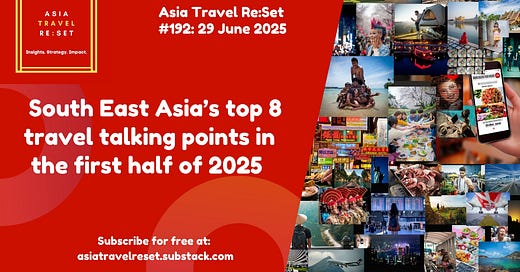Issue #192: South East Asia's Top 8 Travel Talking Points in the First Half of 2025
"I'd be surprised if we get back to 2019 levels for the majority of ASEAN countries."
Welcome to Issue 192 of Asia Travel Re:Set
So, we’ve reached the mid-point of 2025.
Alternatively, we are 6 months out from completing one-quarter of the 21st century.
It’s been a ‘mixed bag’ first half-year in South East Asia - but what have we learned?
What were the developments of consequence, not the short-term headline stories?
Thanks for checking in…
South East Asia's Top 8 Travel Talking Points in H1 2025
Source: Pear Anderson
"I'd be really surprised in 2025 if we get back to 2019 visitor arrivals levels for the majority of countries in South East Asia."
1) Close Conjunction of Lunar New Year & Eid
Lunar New Year is an early-year benchmark for Asia Pacific’s travel calendar. The region enjoyed a strong LNY travel season in late February/early March, but the Eid al-Fitr holidays (just 2 months later) were sub-par, especially in Indonesia. Travel players must adjust their strategies and pricing for a closer conjunction of these 2 prime travel periods. In 2028, LNY and Eid will be just 2 weeks apart.
2) 2019 Shadow Looms Over Inbound Arrivals
See the graphic above. South East Asia’s post-Covid recovery was never likely to be linear. Nevertheless, most ASEAN nations set ambitious visitor arrivals targets for 2025. Although regional airports remain busy, travel economies report mixed results. There are some bright spots (Vietnam), but most countries will struggle to match 2019 levels this year. Thailand and Indonesia face particular challenges.
3) Are Emerging Challenges Structural or Cyclical?
Both. The post-Covid era is over. Travel and tourism in South East Asia are hyper-competitive. The entire landscape is fragmenting and diversifying. Source markets and destination choices are changing. Value-consciousness is growing. External destinations in North East, Central Asia and the Middle East are investing to entice travellers away from South East Asia. Economic structures and cycles are in flux.
4) Low-Cost Carriers Stretch Geographies
AirAsia's expansion plans in Saudi Arabia and Uzbekistan, and VietJet's joint venture in Kazakhstan highlight ASEAN low-cost carriers’ intent to tap mid-haul markets. Stretching geographies to Central Asia and the Middle East reframes LCC economics. How will budget airlines adapt their pricing models? And how will travellers respond?
“The two biggest economies in the region, Indonesia and Thailand, would be expected to be pulling ASEAN further away from [the economic damage of] Covid, but the country driving regional growth at the moment is Vietnam.”
5) Thailand's China-Sized Arrivals Gap
Media chatter is that Thailand is facing a “tourism crisis”. Hitherto, this is untrue. In the first half of 2025 (to 22 June), inbound arrivals fell 4% vs 2024. But, if you consider that Chinese arrivals were 30-35% lower than in the same 2024 period, Thailand’s market diversification is delivering results. Re-upping Chinese visitor volumes is a governmental priority, but political and security challenges loom. Discoveries of explosive devices targeting tourists in Phuket and Krabi presage a tough period ahead.
6) “Worse than the Pandemic”: Indonesia's Austerity Cuts Bite Hard
The Prabowo government’s slashing of departmental budgets and a clampdown on meetings and official travel have hit the domestic travel industry hard. Hotels in regional cities report cratering occupancy rates, revenue slumps and layoffs. Although the policy appears to be loosening, painful damage has been done, the drag effect is continuing and a turnaround will be slow.
7) High Domestic Airfares in Major Markets
High airfares in large geographic entities, like Indonesia, the Philippines, Thailand and Vietnam, continue to hinder domestic tourism. Travellers in Indonesia and the Philippines often report that a return air fare via a neighbouring country is cheaper than flying direct to/from 2 national cities. Political leaders talk about fare ceilings or subsidies during national and regional holidays, but the broader issue goes unresolved.
8) Vietnam is 2025’s Star Performer
Visitor arrivals are South East Asia’s metric of choice - not just for bragging rights, but as a national branding mechanism to court investment. In this context, Vietnam is 2025’s breakout star, with arrivals up 26% from January-May versus 2019. Malaysia is up 6% (January-April), though it lacks Vietnam's dynamism. And a hat-tip to Singapore. Despite being, by a vast margin, ASEAN’s highest-cost destination, it continues to attract tourists with innovative strategies.
The above analysis is summarised from…
On this week’s The South East Asia Travel Show, we review the Top 10 Travel & Tourism Developments from January-June 2025. Our half-year round-up features the still-uncertain outcomes of geo-economic turmoils and US tariffs, contrasting travel patterns during Chinese New Year and Eid, emerging challenges in ASEAN’s international arrivals and geographic expansion by low-cost carriers.
Plus, regulatory scrutiny of OTAs, Thailand’s ‘China-shaped’ tourism struggles, and the diverse gains of Vietnam, Singapore and Malaysia so far in 2025.
⏩ Click on the live link below to listen to South East Asia’s Top 10 Talking Points of 2025 So Far: Travel & Tourism in a New Era of Global Uncertainty.
Or search for The South East Asia Travel Show on any podcast app.
And, that’s a wrap for Issue 192.
Asia Travel Re:Set will return next Sunday. Meantime, find me on LinkedIn.
Happy travels,
Gary






